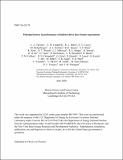Principal factors in performance of indirect-drive laser fusion experiments
Author(s)
Thomas, C.A.; Campbell, E.M.; Baker, K.L.; Casey, D.T.; Hohenberger, M.; Kritcher, A.L.; Spears, B.K.; Khan, S.F.; Nora, R.; Woods, D.T.; Milovich, J.L.; Berger, R.L.; Strozzi, D.; Ho, D.D.; Clark, D.; Bachmann, B.; Benedetti, L.R.; Bionta, R.; Celliers, P.M.; Fittinghoff, D.N.; Grim, G.; Hatarik, R.; Izumi, N.; Kyrala, G.; Ma, T.; Millot, M.; Nagel, S.R.; Patel, P.K.; Yeamans, C.; Nikroo, A.; Tabak, M.; Gatu Johnson, Maria; Volegov, P.L.; Finnegan, S.M.; ... Show more Show less
Download20ja078_full.pdf (531.6Kb)
Metadata
Show full item recordAbstract
Progress in inertial confinement fusion depends on the accurate interpretation of experiments that are complex and difficult to explain with simulations. Results could depend on small changes in the laser pulse or target or physics that are not fully understood or characterized. In this paper we discuss an x-ray-driven platform [K. Baker et al., Phys. Rev. Lett. 121, 135001 (2018)] with fewer sources of degradation, and find the fusion yield can be described as a physically motivated function of laser energy, target scale, and implosion symmetry. This platform and analysis could enable a more experimental approach to the study and optimization of implosion physics.
Description
Submitted for publication in Physics of Plasmas
Date issued
2020-06Department
Massachusetts Institute of Technology. Plasma Science and Fusion CenterJournal
Physics of Plasmas
Publisher
AIP
Other identifiers
20ja078